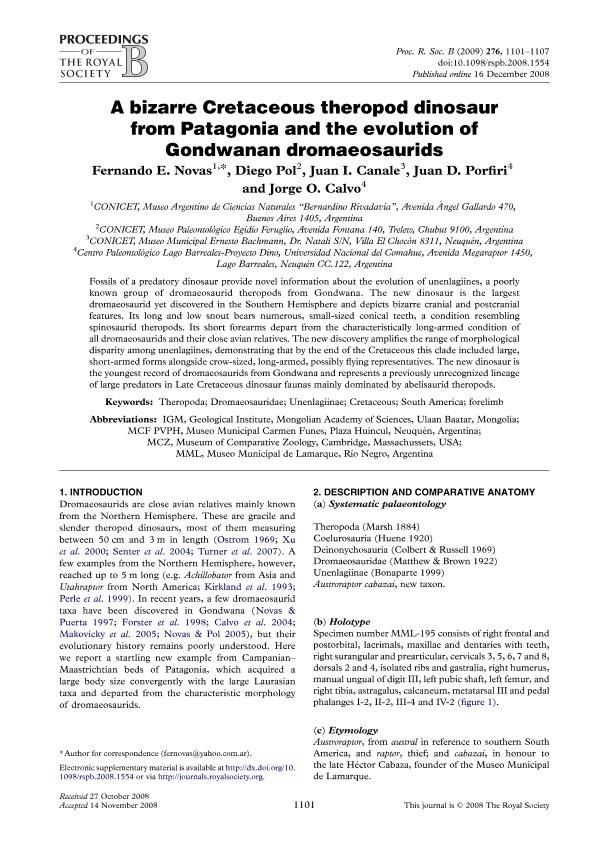Artículo
A bizarre Cretaceous theropod dinosaur from Patagonia and the evolution of Gondwanan dromaeosaurids
Novas, Fernando Emilio ; Pol, Diego
; Pol, Diego ; Canale, Juan Ignacio
; Canale, Juan Ignacio ; Porfiri, Juan Domingo; Calvo, Jorge Orlando
; Porfiri, Juan Domingo; Calvo, Jorge Orlando
 ; Pol, Diego
; Pol, Diego ; Canale, Juan Ignacio
; Canale, Juan Ignacio ; Porfiri, Juan Domingo; Calvo, Jorge Orlando
; Porfiri, Juan Domingo; Calvo, Jorge Orlando
Fecha de publicación:
12/2008
Editorial:
The Royal Society
Revista:
Proceedings of the Royal Society of London. Series B: Biological Sciences
ISSN:
0962-8452
Idioma:
Inglés
Tipo de recurso:
Artículo publicado
Clasificación temática:
Resumen
Fossils of a predatory dinosaur provide novel information about the evolution of unenlagiines, a poorly known group of dromaeosaurid theropods from Gondwana. The new dinosaur is the largest dromaeosaurid yet discovered in the Southern Hemisphere and depicts bizarre cranial and postcranial features. Its long and low snout bears numerous, small-sized conical teeth, a condition resembling spinosaurid theropods. Its short forearms depart from the characteristically long-armed condition of all dromaeosaurids and their close avian relatives. The new discovery amplifies the range of morphological disparity among unenlagiines, demonstrating that by the end of the Cretaceous this clade included large, short-armed forms alongside crow-sized, long-armed, possibly flying representatives. The new dinosaur is the youngest record of dromaeosaurids from Gondwana and represents a previously unrecognized lineage of large predators in Late Cretaceous dinosaur faunas mainly dominated by abelisaurid theropods.
Palabras clave:
Dromaeosauridae
,
Cretaceous
,
SOUTH AMERICA
,
FORELIMB
,
Unenlagiinae
Archivos asociados
Licencia
Identificadores
Colecciones
Articulos(MACNBR)
Articulos de MUSEO ARG.DE CS.NAT "BERNARDINO RIVADAVIA"
Articulos de MUSEO ARG.DE CS.NAT "BERNARDINO RIVADAVIA"
Articulos(SEDE CENTRAL)
Articulos de SEDE CENTRAL
Articulos de SEDE CENTRAL
Citación
Novas, Fernando Emilio; Pol, Diego; Canale, Juan Ignacio; Porfiri, Juan Domingo; Calvo, Jorge Orlando; A bizarre Cretaceous theropod dinosaur from Patagonia and the evolution of Gondwanan dromaeosaurids; The Royal Society; Proceedings of the Royal Society of London. Series B: Biological Sciences; 276; 1659; 12-2008; 1101-1107
Compartir
Altmétricas



